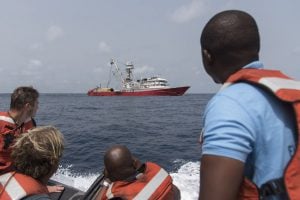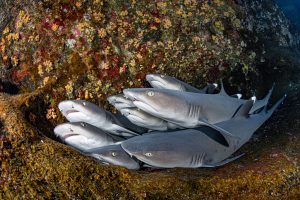Originally a way for fighting ships to communicate, maritime flags have evolved into a complex international language. There exist flags to indicate to other seafarers which way a ship will turn, to appeal for medical assistance and even to warn that a vessel is on fire.
The most significant flag tends to be flown at the stern. Called an ensign, this shows which country the ship is registered in. Like all allegiances, ships can make, break and change their link to individual countries. And it often suits them to, because it changes the rules they must abide by.
This was a popular tactic during the prohibition period in the US. American operators who wanted to serve alcohol onboard realised they could re-register their vessels as operating from Panama to avoid the unpopular US law. Since then, shipowners have selected which country’s flag to fly based on everything from which regime offered the lowest taxes to which allowed cruise lines to perform weddings at sea. It’s not unusual for a ship to leave port flying one nation’s flag and to return proudly displaying the colours of another.
Fisheries
Fishing vessels are no exception to such reflagging. And this can cause a problem for international efforts to regulate the industry and what its sailors are allowed to catch. While fishing boats are officially allowed to reflag, the rules say a vessel should have a genuine link with the country it selects. But unscrupulous operators often select a flag-of-convenience, choosing to register with a country with more relaxed rules. This can allow them to access new fishing grounds or avoid restrictions and penalties.
“Reflagging is a problem because it allows rogue operators to fly under the radar,” says Gilles Hosch, a fisheries expert at Diatom Consulting in Luxembourg. “It reduces the costs associated with illegal fishing and makes it difficult to identify and penalise the real owners of vessels that fish illegally.”
Research from the international maritime intelligence organisation TMT has shown that African coastal states are frequently chosen as flags of convenience by foreign fishing fleets.
Reflagging also makes it harder for the authorities to keep track of a vessel’s identity, especially if it switches often. Vessels that recurrently change their name, flag state or owner are more likely to be involved in illegal, unreported, and unregulated (IUU) fishing. New research now goes some way to addressing this problem. A study led by Global Fishing Watch and published in the journal Science Advances reveals details of how often some fishing vessels change their flags, and offers some clues to their true histories and beneficial owners.
17%
About 17% of high seas fishing is by potentially unauthorised or internationally unregulated vessels, the study found.
“When an operator or owner sells and buys a vessel, they need to change identity or flags. So that’s quite common. But abusive use of this practice might indicate IUU fishing,” says Jaeyoon Park, a researcher with Global Fishing Watch who led the new study.
The researchers used GPS coordinates beamed from boats fitted with a transponder. Collectively known as the automatic identification system (AIS), these transponders are designed to prevent collisions. They track the locations of some 70,000 vessels, including most fishing boats. The researchers could then work out where and when ships were fishing and visiting ports.
Publicly available AIS data provides some ship details but these are open to manipulation. So the study turned to some 40 different public registries that hold details on vessels including name and call sign, dimensions, tonnage, and fishing authorisations.
Then the researchers used machine learning to link the two data sources together, enabling them to compare identifying information on the AIS (who and what the ship claimed to be) with formal details recorded in the registries. This allowed them to track vessels over their lifetimes, and to map how often fishing boats reflagged.
That number was relatively small, with just 3% of identified fishing boats changing their flag in the last decade. But the same was not true for the support vessels that accompany fishing expeditions to carry away the catch or supply fuel. Some 28% of such ships, the study found, had been reflagged in the previous ten years. And while reflagging involved 116 different flag states, some 20% of these countries took part in 80% of flag-switching. Most occurred in Asia, Latin America, Africa and the Pacific Islands – with Panama the most active.
“This kind of information is useful because it allows us to gain a much better understanding of where global fleets are operating,” says Hosch.
How will this information help?
There are several overlapping initiatives already set up that try to make shipping identities and ownership more transparent. These include the Port State Measures Agreement and the Global Record of Fishing Vessels, Refrigerated Transport Vessels and Supply Vessels. Both of these require countries to more rigorously scrutinise ship movements and identities, and are regulated by the UN FAO (United Nations Food and Agriculture Organisation).
The new study results can help these efforts because they can show which ships are known to be playing fair, Park says, which allows the authorities to focus their resources elsewhere.
“Suspicious or illegal activity should be verified by countries and authorities,” he says. “But we can provide some indications so they don’t have to look at everything.”
One possible solution to tracking changes in identity would be to force fishing vessels to carry a unique serial number on their hull, which could be checked and verified. That’s a big step though, and Park says a more practical first step would be to consolidate all the already-available information into a comprehensive and transparent database.
“Only a small portion of fishing activity is suspicious,” he says. “More transparency helps this suspicious behaviour stand out and makes it easier to tackle the problem.”









